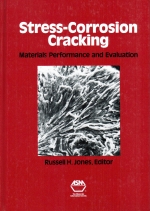Tab Article
STRESS-CORROSION CRACKING (SCC) is a failure process that occurs because of the simultaneous presence of tensile stress, an environment, and a susceptible material. Although manifest mostly in metals, it can also occur in other engineering solids, such as ceramics and polymers. Removal of or changes in any one of these three factors will often eliminate or reduce susceptibility to SCC and therefore are obvious ways of controlling SCC in practice, as is discussed later. Stress-corrosion cracking is a subcritical crack growth phenomenon involving crack initiation at selected sites, crack propagation, and overload final fracture of the remaining section. Failure by SCC is frequently encountered in seemingly mild chemical environments at tensile stresses well below the yield strength of the metal. The failures often take the form of fine cracks that penetrate deeply into the metal, with little or no evidence of corrosion on the nearby surface or distortion of the surrounding structure. Therefore during casual inspection no macroscopic evidence of impending failure is seen. Stress-corrosion cracking continues to be a cause of significant service failures. It is very likely that for every alloy there is an environment that will cause SCC, but, fortunately, most of the ones of industrial significance are known and avoidable. Changes in one or more of the three necessary factors—material, stress, and environment—can prevent or mitigate SCC, either in design or after a problem has occurred in the field. Material selection and specification is the first line of defense. Lowering of the applied stresses and elimination of residual stresses can go a long way toward eliminating problems too. Sometimes minor changes or additions to the environment can help. Finally, proper design and operation to avoid such things as splash zones and wet/dry concentration also are important. Stress-corrosion cracking is a dangerous and severe degradation mechanism, but with proper understanding and care, failures can be avoided. Several processes in addition to SCC, such as corrosion fatigue, hydrogen embrittlement, and fretting corrosion can cause failure of metals exposed to an environment. All of these are reviewed in other articles in this Volume. This article is intended to include a brief review of stress corrosion and a discussion of the analysis of SCC service failures and their occurrence in commercial alloys in actual service. The reader interested in more detail on the theories and mechanisms of SCC is referred to other Handbook articles ( Ref, ), review articles (Ref, , , , , ), and the Selected References listed at the end of this article.


